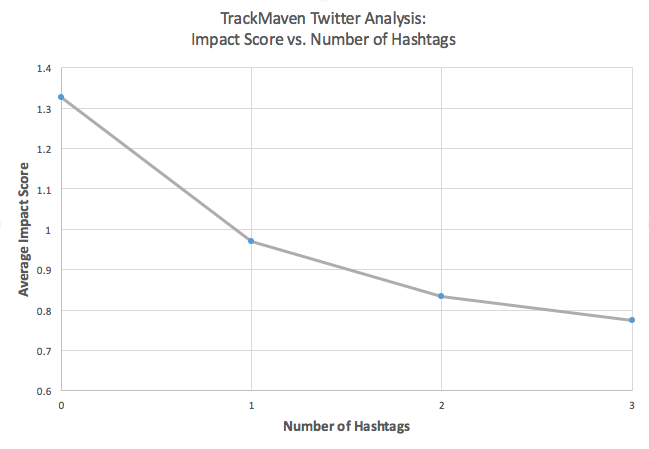After becoming TrackMaven’s Community Manager about six months ago, I was eager to learn more about the marketing technology industry and what works best for my brand on social. Part of my goal was to experiment with a variety of tactics on Twitter – such as the best Twitter hashtags and optimal tweet length – to figure out how to optimize tweets in order to create the most impact for @TrackMaven.
One of the key tools I use to evaluate, experiment, and explore tweet tactics is the TrackMaven platform itself. I am particularly interested in optimizing the components that are the easiest to isolate and control, such as hashtag use, post type, and text length. If I can figure out the optimal practices for each of those options, then it’s easy to pursue those practices moving forward.
How we use TrackMaven to optimize tweets
I used the TrackMaven platform to analyze the optimal number of hashtags, words, and characters in tweets on the TrackMaven Twitter account over the past 90 days. I also analyzed the type of hashtag and whether or not to include a photo or link. I ranked the effect of each variable by the TrackMaven impact score, or how many more interactions that post received compared to the brand’s average from the prior 30 days. For example, a tweet with a “2X” impact score received two times more more interactions than the brand’s rolling average.
How many hashtags should I include in a tweet?
The most interesting results from my examination of TrackMaven’s Twitter performance was in exploring the optimal number of hashtags to use in a tweet. Take a look:
The results were particularly fascinating for two reasons:
- These results fly in the face of common best practices for Twitter, which typically advise that using one to two hashtags is best for getting your tweet included in those topical conversations.
- The results follow a clear trend. The more hashtags used, the lower the impact score. No exceptions. That’s pretty impressive from a statistical standpoint, and drives home the conclusion that for our brand, at least, the fewer hashtags we use, the better.
There is one important factor in the tweets without hashtags that performed well: the inclusion of mentions of other brands and individuals. For example, we started a friendly staring contest with our D.C. Tech neighbors at FiscalNote, using our pop-up MegaMaven. We kicked it off with this tweet:
.@FiscalNote let the staring contest begin pic.twitter.com/KRXwayaOln
— TrackMaven (@TrackMaven) April 14, 2016
We wanted to start a fun Twitter conversation, and it worked — #MascotsofThomasCircle received a lot of interactions.
What are the best Twitter hashtags for my brand?
The best performing hashtags were also an interesting find in my investigation. One notable trend is the standout performance of national days and special events.
Here are the top 20 best Twitter hashtags for our brand:
A couple of our higher scoring tweets took advantage of the real-time social conversation Twitter offers. One was from this week’s #GoSkateboardingDay when a couple hundred skateboarders went by the TrackMaven office in DC. I captured the moment in a Snapchat video, then shared that video on Twitter:
Happy #GoSkateboardingDay! Check out these DC skaters, then download our holidays calendar: https://t.co/8bU07GoEL2 pic.twitter.com/rDBSfPCj8I
— TrackMaven (@TrackMaven) June 21, 2016
Another somewhat spontaneous tweet was around the National Park Service’s centennial anniversary, using #NPS100, and the #FindYourPark campaign. (Fun fact: This is a photo I took of my climbing gear, which includes water bottles with TrackMaven stickers on them.) Check it out:
It’s a beautiful weekend to celebrate #nps100 — get outside and #FindYourPark! pic.twitter.com/DfWkB0WvQF
— TrackMaven (@TrackMaven) June 18, 2016
I sent these out in the first place because of the success our national days tweets have had in the past, which motivated me to take advantage of more holidays and special events from a more personal, but still brand-related, perspective. If you’d like to test the impact of national days in your social strategy, check out our gigantic list of holidays and national days.
Should my tweet have a link, a photo, or just text?
The types of tweets that received the highest impact scores were also interesting. Tweets with photos see the highest impact score, followed by text-only tweets, tweets with links, and, lastly, tweets with a photo and a link.
One of the biggest takeaways from this data is the performance of the link posts over the photo and link posts. This demonstrates to me that I should be taking more advantage of Twitter cards, rather than including a link and uploading a separate photo for each tweet. (I’d been on the fence about this previously and had experimented with both.)
Another big takeaway is the success of tweets with a photo, but no link. While these tweets are great for engagement, keep in mind that you’re losing out on an opportunity to push people to your brand’s website.
How long should my tweet be?
The optimal number of words or characters was harder to pin down. There were several exceptions, but overall, the character length sweet spot for us seems to be 80 to 100 characters. Take a look:
As far as number of words go, generally tweets with about 17 to 20 words performed best, with a couple of exceptions. Check it out:
It would be interesting to compare optimal number of characters to optimal number of words in order to determine whether to use big words or small words, but we’re still sticking with low-hanging fruit: variables that are easy to isolate and control in order to improve the impact of @TrackMaven’s tweets.
How to I get access to this Twitter data?
My recommendation is to request for a demo of the TrackMaven platform. The members of our customer success team are aces and can help get your marketing data to work for you and your brand, so you can get back to creating better content. Request a demo today!






